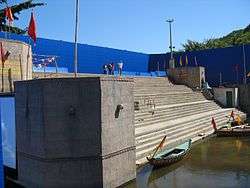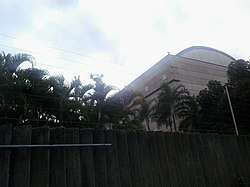Estúdios Globo
Estúdios Globo (Globo Studios, in English), formerly known as Projac, is the main center of television production of the Grupo Globo and Latin Americas largest audio-visual production center.[1] Opened in 1995, it is located in the city of Rio de Janeiro, Brazil. Often is called of CGP-Central Globo de Produção (Globo Production Center). The CGP-Central Globo de Produção (Globo Production Center), located in Curicica, Jacarepaguá, is the largest production center in the world, with an area of 1 million and 600 thousand m2, housing studios, fictional cities, islands of editing, post production, special effects, factory settings, costumes, technical support to production, administration and services.[2] Currently, Projac holds twelve recording studios, three snack bars, a restaurant, bank. They are often building new studios, centers support to fictional cities, a theater and an administrative building. In 2016, Projac rename as Estúdios Globo (Globo Studios).
| Company of Rede Globo | |
| Genre | Television and film production company |
| Founded | 1995 |
| Headquarters | Rio de Janeiro, Brazil |
| Owner | Rede Globo |
| Parent | Grupo Globo |
History
The former Rede Globo studios, opened in 1965, were too small for the station's productions. In 1975, the Teatro Fênix was inaugurated, for the production of auditorium programs. In 1980, it was found that the station's facilities would become improper in a short time. Projac (then called Jacarepaguá Project) was designed to house the studios, administration, production, direction; and leave the Botanical Garden. The greatness of Projac, between conception and inauguration, constitutes an undertaking that took almost fifteen years to be completed. In the long interval between the departure of Globo from its former studios and the definitive entry into Projac, the broadcaster rented other spaces, such as Atlântida Cinematográfica, Cyll Farney's Tycoon studios, part of Renato Aragão's studios, TV Tupi's studios at the old Cassino da Urca, Pólo Rio de Cinema e Vídeo and the Herbert Richers studios, besides producing some programs at the Teatro Fênix.
On August 8, 2019, the Production Module 4 (MG4) was inaugurated, incorporating three new studios (K, L, M), with a built area of 26,000 m². The complex now occupies a total area of 1.73 million m², with thirteen production studios, expanding the production capacity of soap operas, series, miniseries, realities, original formats, humor shows and varieties.[3]
Productions


Split of studios
Studio A
Studio B
- O Tempo não Para
Studio C
Studio D
Studio E
- Caldeirão do Huck
- The Voice Kids
- Popstar
Studio F
- Lady Night (for the Multishow)
- "Who wants to be a Millionaire?" (attraction of Caldeirão do Huck)
- Os Melhores Anos de Nossas Vidas
Studio G
Studio H
- Malhação: Brazilian Lives
Studio I
- Zorra (television program)
- Escolinha do Professor Raimundo (2015)
- Programa do Herbert
Studio J
- Se Eu Fechar os Olhos Agora
Studio K
Studio L
VACANT
Studio M
VACANT
Programs recorded elsewhere in the complex
- Mais Você
- É de Casa
- Big Brother Brasil (January to April)
References
- "INA Global - Television - Article - Organizações Globo". INA Global. Retrieved May 29, 2011.
- Rede Globo
- G1, Globo (8 August 2019). "Globo inaugura novos estúdios e celebra o talento no maior complexo de produção de conteúdo da América Latina". Grupo Globo. Retrieved 8 August 2019.